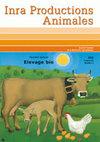通过饮食控制牛奶中脂肪酸和维生素化合物的含量
IF 0.6
4区 农林科学
Q3 Agricultural and Biological Sciences
引用次数: 6
摘要
本文综述了牛奶脂肪酸和维生素的消化代谢来源,介绍了主要营养因素对其浓度的影响。与冬季饲粮相比,放牧降低了乳中饱和脂肪酸的含量,有利于反式和多不饱和脂肪酸,包括C18:3n-3和c9t11-CLA。短期和长期在奶牛饲粮中添加亚麻籽或油菜籽均可提高牛奶中反式脂肪酸的含量,并略有增加c9t11-CLA的含量。与吃油菜籽的奶牛相比,吃亚麻籽的奶牛所产的牛奶中C18:3n-3含量较高,而c9-C18:1含量较低。这些反应取决于牧草性质、淀粉含量和油籽性质之间的相互作用。单宁或精油的添加对牛奶脂肪酸组成影响不大。除了维生素B12,牛奶中的所有维生素都可以来自含有维生素A、E和D3的饲料或浓缩物和/或矿物质预混料。反刍动物还能从食物前体中合成维生素A、C、B3和D。维生素B和维生素K是由瘤胃细菌合成的。除了维生素a外,改变牛奶维生素浓度的营养因素没有很好的文献记载。然而,喂养是提高牛奶营养质量的重要工具。本文章由计算机程序翻译,如有差异,请以英文原文为准。
Maîtrise par l’alimentation des teneurs en acides gras et en composés vitaminiques du lait de vache
This paper, after summarising the digestive and metabolic origins of milk fatty acids and vitamins, presents the effects of the main nutritional factors on their concentration. Grazed grass, when compared to winter diets, decreased the milk content of saturated fatty acids, in favor of trans and polyunsaturated fatty acids, including C18:3n-3 and c9t11-CLA. Short- and long-term supplementation of dairy cow diets with linseed or rapeseed increased the milk content of trans fatty acids and slightly c9t11-CLA. Cows fed linseed produced milks richer in C18:3n-3 and poorer in c9-C18:1 than those fed rapeseed. The responses depend on interactions among the nature of the forage, starch content and oilseed nature. The addition of tannins or essential oils has little influence on milk fatty acid composition. Except for the B12 vitamin, all vitamins present in milk can originate from forages or concentrate, and/or mineral premix containing A, E and D3 vitamins. The ruminant can also synthesize A, C, B3, and D vitamins from dietary precursors. The B and K vitamins are synthesized by rumen bacteria. The nutritional factors altering milk vitamin concentrations are not well documented, except for vitamin A. Nevertheless, feeding is an important tool to improve milk nutritional quality.
求助全文
通过发布文献求助,成功后即可免费获取论文全文。
去求助
来源期刊

Inra Productions Animales
Multiple-
CiteScore
1.30
自引率
33.30%
发文量
0
审稿时长
>36 weeks
期刊介绍:
This journal publishes scientific update reports, results of experiments and their possible applications, analyses on topical issues and presentation of research, information on scientific events and new publications.
INRA Productions Animales deals with all species of zootechnical interest (herbivores, monogastrics and fish), covering feed and nutrition, physiology, pathology, genetics, production techniques, product quality and production economics.
 求助内容:
求助内容: 应助结果提醒方式:
应助结果提醒方式:


